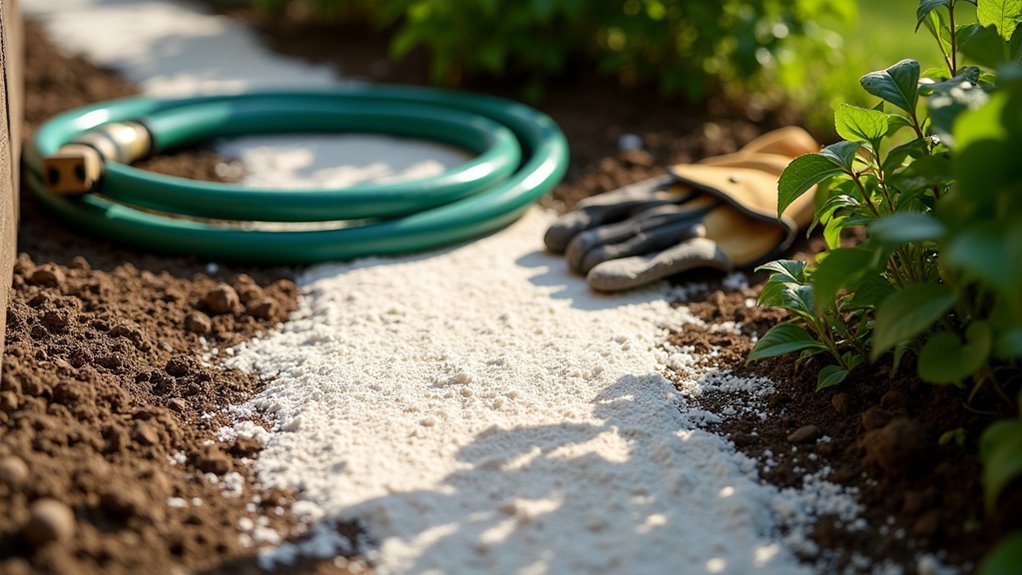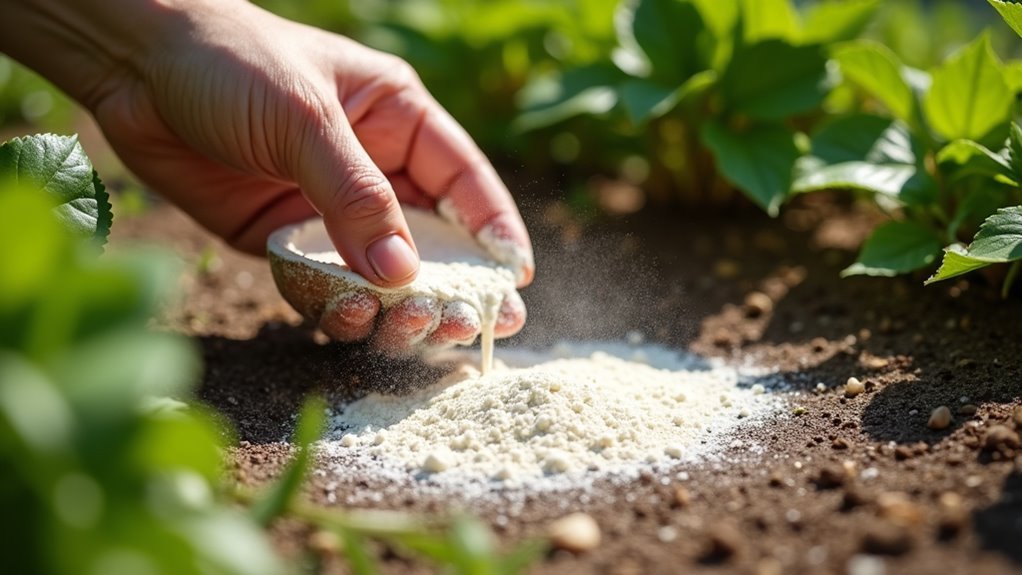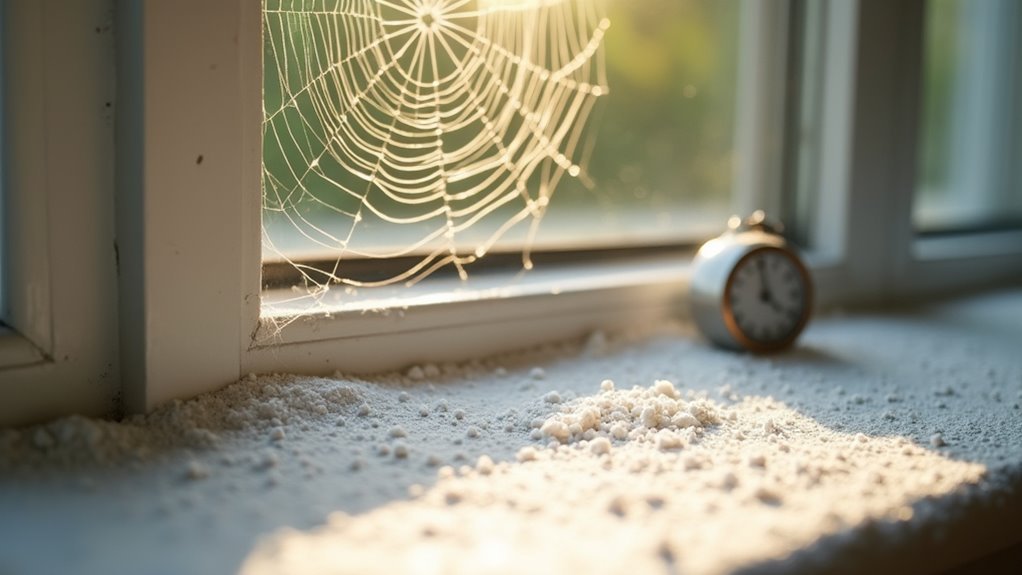You’ll achieve effective spider control by applying diatomaceous earth in thin 1/4-inch layers around entry points like doors, windows, and foundation cracks. Target high-traffic indoor areas including baseboards, corners, and dark hiding spots in basements or attics using a powder duster for precision. Create protective barrier zones around your home’s perimeter, reapplying weekly in moisture-prone areas. Combine treatments with environmental modifications like sealing gaps and removing clutter for superior results that’ll transform your spider problem permanently.
Strategic Application Around Entry Points and Foundation Perimeters

When applying diatomaceous earth for spider control, you’ll want to focus on creating strategic barriers around your home’s most vulnerable entry points.
Apply a thin layer around doors, windows, and foundation cracks where spiders typically enter. Pay special attention to gaps around pipes and unsealed vents, ensuring even distribution for maximum effectiveness.
For your foundation perimeter, create an outdoor barrier by sprinkling diatomaceous earth at 1/4 inch thickness around your home’s exterior. This natural pest control method provides effective pest control when properly maintained.
You’ll need to reapply weekly, especially after cleaning or moisture exposure.
Monitor application areas regularly and replenish as needed, keeping the powder dry and undisturbed to deter spiders from bypassing treated zones.
Indoor Treatment of High-Traffic Spider Areas and Hiding Spots
Three key indoor zones require your focused attention when treating spider infestations with diatomaceous earth.
Apply a thin layer of diatomaceous earth around high-traffic areas including baseboards, corners, and entryways where spiders frequently travel.
Focus your spider control efforts on dark, damp hiding spots like basements, attics, and storage spaces where these pests seek shelter.
Use a powder duster for precise application in hard-to-reach areas, preventing excessive dust dispersal while ensuring maximum contact.
Keep treated spaces clean and clutter-free to enhance effectiveness.
Reapply diatomaceous earth weekly in areas with high spider activity or moisture exposure to maintain control.
Regularly clean and vacuum treated areas to prevent dust accumulation and preserve the product’s pest control efficacy throughout your home.
Creating Protective Barrier Zones Using Proper Powder Distribution

Strategic placement of diatomaceous earth creates impenetrable barrier zones that block spiders from entering your home’s most vulnerable access points. Apply a thin layer approximately 1/4 inch thick around doors, windows, and cracks to establish an effective barrier for spider control.
| Location | Application Method | Maintenance |
|---|---|---|
| Entry Points | 1/4 inch thin layer around doors/windows | Weekly reapplication |
| Dark and damp areas | Focus on corners and baseboards | After moisture exposure |
| Foundation perimeter | Distribute around exterior base | Every seven days |
| Hard-to-reach spots | Use powder duster for precise application | Keep dry for ideal performance |
| Vegetation areas | Apply near plants and shrubs | Monitor effectiveness regularly |
Target basements and attics where spiders hide, ensuring powder remains dry for ideal performance. Reapply diatomaceous earth weekly or after moisture exposure to maintain protection.
Combining Diatomaceous Earth With Environmental Modifications
While barrier zones provide excellent spider protection, you’ll achieve superior results by pairing diatomaceous earth with targeted environmental modifications that address the root causes of spider infestations.
Start by sealing cracks and gaps around doors and windows to reduce entry points for spiders, making your diatomaceous earth applications more effective. Keeping your home clean and clutter-free eliminates hiding spots where spiders typically nest.
When you apply diatomaceous earth in dark, damp areas like basements and attics, you’re targeting their preferred habitats. Remove outdoor attractants such as leaf piles and standing water to eliminate food sources that draw spiders.
This thorough pest control approach guarantees you keep spiders away more effectively than using diatomaceous earth alone.
Reapplication Timing and Maintenance for Long-Term Spider Prevention

Because diatomaceous earth loses its effectiveness when disturbed or wet, you’ll need to establish a consistent reapplication schedule to maintain long-term spider control.
Reapply diatomaceous earth weekly in areas with high moisture or significant spider activity. Always maintain a thin layer, as thick applications won’t effectively kill spiders. Focus on high-traffic areas and potential entry points like doors, windows, and cracks where spiders commonly enter your home.
Monitor treated areas regularly for spider activity and signs of disturbance. Reapply immediately after rain, cleaning, or when the powder appears disturbed.
Moisture diminishes effectiveness, so check applications more frequently in damp areas. Consistent use creates a reliable long-term barrier against spider infestations, keeping your home protected when you maintain proper reapplication timing.
Frequently Asked Questions
How Long Does It Take Diatomaceous Earth to Kill Spiders?
You’ll typically see diatomaceous earth kill spiders within 24-72 hours after direct contact. The abrasive powder damages their exoskeleton, causing dehydration. However, it can take several days depending on humidity levels.
Why Do Exterminators Not Use Diatomaceous Earth?
Exterminators don’t use diatomaceous earth because it’s slow-acting, requires frequent reapplication, and needs perfect conditions to work effectively. You’ll find they prefer faster chemical solutions for immediate results.
What Is the Best Way to Apply Diatomaceous Earth?
You’ll want to apply a thin 1/4-inch layer around entry points using a powder duster. Focus on dark, damp areas like basements and corners, then reapply weekly for best results.
What Are the Downsides of Diatomaceous Earth?
You’ll face respiratory risks from inhaling dust, reduced effectiveness when overapplied or wet, harm to beneficial insects, and incomplete pest control since it doesn’t address infestation sources requiring additional methods.
In Summary
You’ll achieve effective spider control by implementing these five diatomaceous earth techniques consistently. Focus on strategic placement around entry points, treat indoor hiding spots thoroughly, and establish protective barriers throughout your property. Don’t forget to combine DE application with environmental modifications like reducing moisture and clutter. Remember that reapplication every few weeks guarantees continuous protection, giving you long-term results against unwanted spider invasions in your home.





Leave a Reply